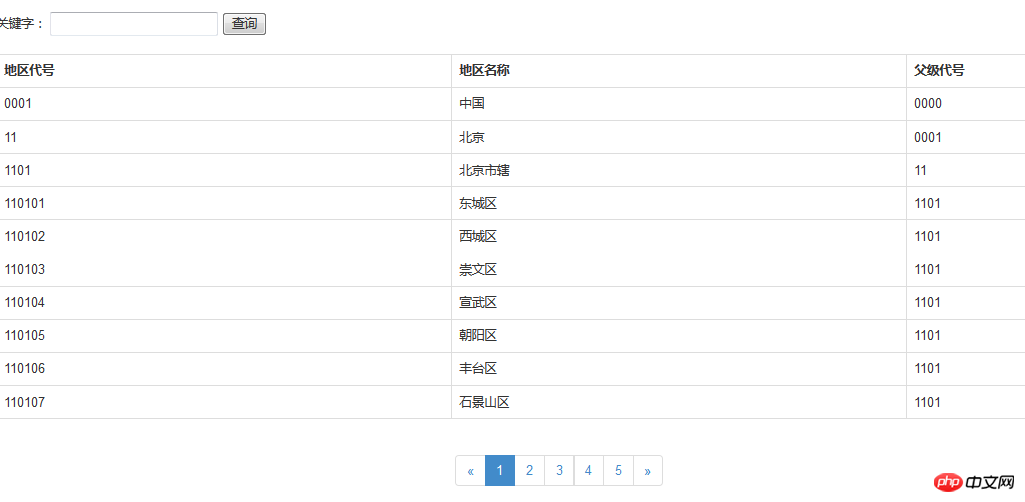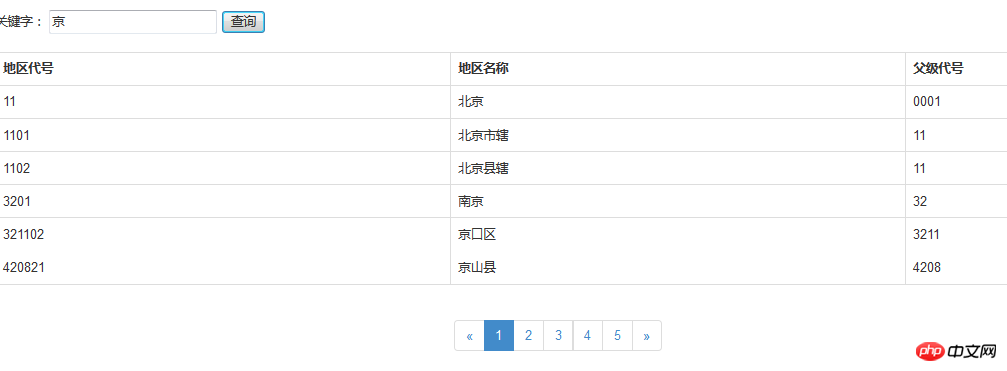Maison >développement back-end >tutoriel php >Comment utiliser jQuery+Ajax pour implémenter une requête de pagination multifonction en PHP
Comment utiliser jQuery+Ajax pour implémenter une requête de pagination multifonction en PHP
- 一个新手original
- 2017-09-28 10:22:321490parcourir
1. Créez d'abord la page principale Ajax_pag.php
Le code est le suivant :
<!DOCTYPE html>
<html>
<head>
<meta charset="UTF-8">
<title>Ajax做分页</title>
<script src="bootstrap/js/jquery-1.11.2.min.js"></script>
<script src="Ajax_pag.js"></script>
<script src="bootstrap/js/bootstrap.min.js"></script>
<link href="bootstrap/css/bootstrap.min.css" rel="stylesheet" type="text/css"/>
</head>
<style>
.header{
margin-top: 20px;
} </style>
<body>
<p style="margin-top: 20px; margin-top: 20px;">
关键字: <input id="key" type="text" name="gjz"/>
<input type="button" value="查询" id="ck" />
</p>
<table class="table table-bordered header">
<thead>
<tr>
<th>地区代号</th>
<th>地区名称</th>
<th>父级代号</th>
</tr>
</thead>
<tbody id="list">
</tbody>
</table>
<p style="margin:0 auto; width:500px;">
<ul class="pagination" id="fenye">
</ul>
</p>
</body>
</html>2. Page JS Ajax_pag.js
Le code est le suivant :
//ajax分页开始 var ts = 10;
//每页显示的条数 var page = 1;
//当前页 $(document).ready(function(e) {
//页面加载数据 Load();
//加载分页列表 Loadlist();
$("#ck").click(function() {
//页面加载数据 Load();
//加载分页列表 Loadlist();
}
)
}
) //加载数据的方法 function Load() {
var gjz = $("#key").val();
$.ajax( {
async:false, url:"pagechuli.php", data: {
page:page,ts:ts,gjz:gjz
}
,//page是显示的页数;ts是显示的条数 type:"POST", dataType:"JSON", success: function(data) {
var str ="";
for(var k in data) {
str +="<tr><td>"+data[k][0]+"</td><td>"+data[k][1]+"</td><td>"+data[k][2]+"</td></tr>";
}
$("#list").html(str);
//把拼接好的字符串放到要显示的thody里面 }
}) }
//加载分页列表 function Loadlist() {
var str ="";
//上一页 str+="<li><a id='prev'>«
</a></li>";
//加载列表 for(var i=page-4;
i<page+5;
i++) {
//限制条件 if(i>0 && i<=zys()) {
//判断当前页 if(i==page) {
str+= "<li class='active'><a>"+i+"</a></li>";
}
else {
str+= "<li><a class='item'>"+i+"</a></li>";
}
} }
//下一页 str+="<li><a id='next'>»
</a></li>";
$("#fenye").html(str);
$("#prev").click(function() {
if(page>1) {
page--;
}
//页面加载数据 Load();
//加载分页列表 Loadlist();
}
) $(".item").click(function() {
var p = $(this).text();
//取到的是字符串,转化为整数 page = parseInt(p);
//页面加载数据 Load();
//加载分页列表 Loadlist();
}
) $("#next").click(function() {
if(page<zys()) {
page++;
}
//页面加载数据 Load();
//加载分页列表 Loadlist();
}
) }
//总页数 function zys() {
var zys = 0;
$.ajax( {
async:false, url:"zyschuli.php", dataType:"TEXT", success:function(data) {
zys = Math.ceil(data/ts);
}
});
return zys;
}3 Enfin, effectuez la page de traitement des requêtes de pagination pagechuli.php
Le code est le suivant. :
<?php
$gjz = $_POST["gjz"];
$page = $_POST["page"];
//获取页数显示值$ts = $_POST["ts"];
//获取每页条数显示值require_once "./DBDA.class.php";
$db = new DBDA();
$tj = " 1=1 ";
if(!empty($_POST["gjz"])) {
$gjz = $_POST["gjz"];
$tj = " areaname like '% {
$gjz
}
%' or areacode like '% {
$gjz
}
%' or parentareacode like '% {
$gjz
}
%' ";
}
$tg = ($page-1)*$ts;
//每页显示$ts条数据,这里显示的就是当前页的$tg条数据。$sql = "select * from chinastates where {
$tj
}
limit {
$tg
}
, {
$ts
}
";
echo $db->JsonQuery($sql,0)Widget : Total La page de traitement du numéro de page zyschuli.php
<?php
require_once "./DBDA.class.php";
$db = new DBDA();
$sql = "select count(*) from chinastates";
echo $db->StrQuery($sql,0);L'effet est le suivant : 

Demande de mots clés : 
Ce qui précède est le contenu détaillé de. pour plus d'informations, suivez d'autres articles connexes sur le site Web de PHP en chinois!
Déclaration:
Le contenu de cet article est volontairement contribué par les internautes et les droits d'auteur appartiennent à l'auteur original. Ce site n'assume aucune responsabilité légale correspondante. Si vous trouvez un contenu suspecté de plagiat ou de contrefaçon, veuillez contacter admin@php.cn
Article précédent:Comment lire une taille de fichier 1G en PHPArticle suivant:Comment lire une taille de fichier 1G en PHP
Articles Liés
Voir plus- Comment utiliser cURL pour implémenter les requêtes Get et Post en PHP
- Comment utiliser cURL pour implémenter les requêtes Get et Post en PHP
- Comment utiliser cURL pour implémenter les requêtes Get et Post en PHP
- Comment utiliser cURL pour implémenter les requêtes Get et Post en PHP
- Tous les symboles d'expression dans les expressions régulières (résumé)

